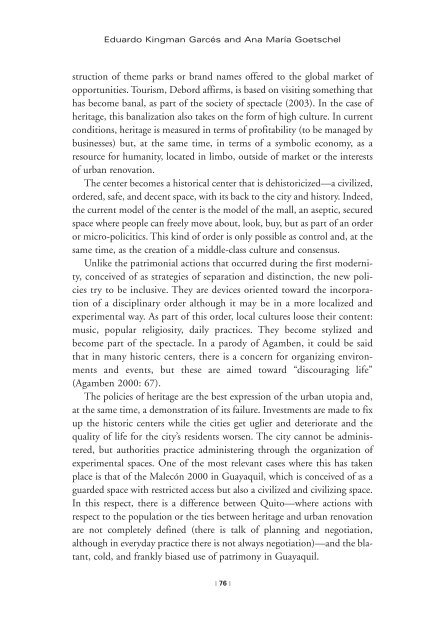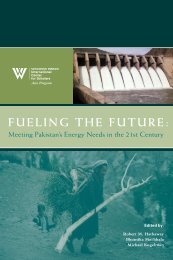urban regeneration and revitalization in the americas - Woodrow ...
urban regeneration and revitalization in the americas - Woodrow ...
urban regeneration and revitalization in the americas - Woodrow ...
You also want an ePaper? Increase the reach of your titles
YUMPU automatically turns print PDFs into web optimized ePapers that Google loves.
Eduardo K<strong>in</strong>gman Garcés <strong>and</strong> Ana María Goetschel<br />
struction of <strong>the</strong>me parks or br<strong>and</strong> names offered to <strong>the</strong> global market of<br />
opportunities. Tourism, Debord affirms, is based on visit<strong>in</strong>g someth<strong>in</strong>g that<br />
has become banal, as part of <strong>the</strong> society of spectacle (2003). In <strong>the</strong> case of<br />
heritage, this banalization also takes on <strong>the</strong> form of high culture. In current<br />
conditions, heritage is measured <strong>in</strong> terms of profitability (to be managed by<br />
bus<strong>in</strong>esses) but, at <strong>the</strong> same time, <strong>in</strong> terms of a symbolic economy, as a<br />
resource for humanity, located <strong>in</strong> limbo, outside of market or <strong>the</strong> <strong>in</strong>terests<br />
of <strong>urban</strong> renovation.<br />
The center becomes a historical center that is dehistoricized—a civilized,<br />
ordered, safe, <strong>and</strong> decent space, with its back to <strong>the</strong> city <strong>and</strong> history. Indeed,<br />
<strong>the</strong> current model of <strong>the</strong> center is <strong>the</strong> model of <strong>the</strong> mall, an aseptic, secured<br />
space where people can freely move about, look, buy, but as part of an order<br />
or micro-policitics. This k<strong>in</strong>d of order is only possible as control <strong>and</strong>, at <strong>the</strong><br />
same time, as <strong>the</strong> creation of a middle-class culture <strong>and</strong> consensus.<br />
Unlike <strong>the</strong> patrimonial actions that occurred dur<strong>in</strong>g <strong>the</strong> first modernity,<br />
conceived of as strategies of separation <strong>and</strong> dist<strong>in</strong>ction, <strong>the</strong> new policies<br />
try to be <strong>in</strong>clusive. They are devices oriented toward <strong>the</strong> <strong>in</strong>corporation<br />
of a discipl<strong>in</strong>ary order although it may be <strong>in</strong> a more localized <strong>and</strong><br />
experimental way. As part of this order, local cultures loose <strong>the</strong>ir content:<br />
music, popular religiosity, daily practices. They become stylized <strong>and</strong><br />
become part of <strong>the</strong> spectacle. In a parody of Agamben, it could be said<br />
that <strong>in</strong> many historic centers, <strong>the</strong>re is a concern for organiz<strong>in</strong>g environments<br />
<strong>and</strong> events, but <strong>the</strong>se are aimed toward “discourag<strong>in</strong>g life”<br />
(Agamben 2000: 67).<br />
The policies of heritage are <strong>the</strong> best expression of <strong>the</strong> <strong>urban</strong> utopia <strong>and</strong>,<br />
at <strong>the</strong> same time, a demonstration of its failure. Investments are made to fix<br />
up <strong>the</strong> historic centers while <strong>the</strong> cities get uglier <strong>and</strong> deteriorate <strong>and</strong> <strong>the</strong><br />
quality of life for <strong>the</strong> city’s residents worsen. The city cannot be adm<strong>in</strong>istered,<br />
but authorities practice adm<strong>in</strong>ister<strong>in</strong>g through <strong>the</strong> organization of<br />
experimental spaces. One of <strong>the</strong> most relevant cases where this has taken<br />
place is that of <strong>the</strong> Malecón 2000 <strong>in</strong> Guayaquil, which is conceived of as a<br />
guarded space with restricted access but also a civilized <strong>and</strong> civiliz<strong>in</strong>g space.<br />
In this respect, <strong>the</strong>re is a difference between Quito—where actions with<br />
respect to <strong>the</strong> population or <strong>the</strong> ties between heritage <strong>and</strong> <strong>urban</strong> renovation<br />
are not completely def<strong>in</strong>ed (<strong>the</strong>re is talk of plann<strong>in</strong>g <strong>and</strong> negotiation,<br />
although <strong>in</strong> everyday practice <strong>the</strong>re is not always negotiation)—<strong>and</strong> <strong>the</strong> blatant,<br />
cold, <strong>and</strong> frankly biased use of patrimony <strong>in</strong> Guayaquil.<br />
| 76 |

















